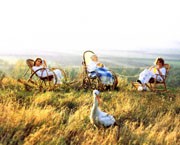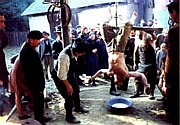Ask an English critic about Slovak cinema and you are likely to draw a blank. Apart from confusions about Czechs and Slovaks, a look at the records reveals that only two Slovak films have ever been released in the UK—Juraj Jakubisko's Zbehovia a pútnici ( The Deserter and the Nomads, 1968) in 1970 and Juraj Herz's Sladké hry minulého leta (Sweet Games of Last Summer, 1969) in 1973.
Slovakia's forgotten influence
For those who know, of course, there is a significant tradition. Štefan Uher's "new form" film Slnko v sieti (Sunshine in a Net, 1962) arguably initiated the aesthetic climate that gave birth to the Czech and Slovak New Waves of the sixties. In the late sixties, the work of Juraj Jakubisko, Elo Havetta and Dušan Hanák established a recognisable school of Slovak cinema.
The use of folk culture and carnival as a living tradition, an approach later associated with Yugoslav directors like Emir Kusturica, was already being pioneered by directors such as Jakubisko (dubbed "the Slovak Fellini") and Havetta. Unfortunately, their first and probably their best films coincided with the Prague Spring and the Soviet invasion of 1968, leading to an extended ban and a curtailing of international recognition.
Slovak production was maintained after the onset of "normalisation" and often attained a level of originality and interest above that of its Czech counterpart. The number of features was sustained at around eleven a year until 1990, subsequently falling to an overall average of two features with a total of only one film a year in 1998 and 1999.
Rebirth of a national cinema
The end of state funding and the split-up of Czechoslovakia seemed to have dealt a death blow to the Slovak industry. Jakubisko has left for the Czech Republic and other Slovak film-makers have had to find work there. Hanák has completed only one film—the documentary Papierové hlavy (Paper  Heads, 1995). Only the talented Martin Šulík seems to have transcended it all with a succession of five features, including the internationally acclaimed Záhrada (The Garden, 1995) and, this year, Krajinka (The Landscape).
Heads, 1995). Only the talented Martin Šulík seems to have transcended it all with a succession of five features, including the internationally acclaimed Záhrada (The Garden, 1995) and, this year, Krajinka (The Landscape).
It was against this background of both public and official apathy that the Bratislava International Film Festival made its debut in 1999. In the age of the US-dominated mainstream, of course, film festivals have developed into something like an alternative distribution system. For two weeks of the year, the rest of the world and the history of the cinema are resurrected. But one senses that Bratislava has a more radical aim—to kickstart film culture in the broader sense and to recreate a climate in which Slovak cinema can develop.
Going international
A prime objective, of course, is to present international festival successes of the past year. The 2000 festival, taking place early in December at Istropolis centre and Ster Century Cinemas, provided opportunities to see, for instance, Dancer in the Dark, Songs from the Second Floor, La Liaison Pornographique, Ghost Dog: The Way of the Samurai, Shadow of the Vampire, Angela's Ashes and American Psycho. With no less than nine separate strands, the festival's emphasis was international and pan-European, focusing on the work of young directors.
In its EC-sponsored European strand, it emphasised films that, as Festival Director Peter Nágel put it, often had difficulty finding distribution even in their own country. More specialised strands were devoted to Philippine cinema, a profile of Finnish director Mika Kaurismäki, as well as the intriguingly titled "Free Zone: Special Forms of Erotic Life." The Festival competition for first and second feature films split its awards between Lynne Ramsay's Ratcatcher (Grand Prix and Best Actress) and Lee Chang-dong's Peppermint Candy (Best Direction and Best Actor). Ramsay's British—or rather Scottish—film is an excellent example of Nágel's point.
One of the most interesting initiatives was the inauguration of what is planned as a regular strand building on film links between the Visegrád countries (Poland, Hungary, Czech Republic, Slovakia). Documentary films proved of particular interest, with screenings for Rudolf Krejčík's suppressed 7 dní (Seven Days to Remember, 1968), on the Prague Spring, Mad'arsko: 1956 (Hungary: 1956), specially compiled for the Bratislava Festival, and the classic account of the triumph of Solidarity in 1980, Robotnicy '80 (Workers '80, Chodokowski and Zajaczkowski, 1980).
Features selected extended back to Martin Frič's Czech-Polish Dvanáct křesel (The Twelve Chairs, 1933), adapted from the story by Ilf and  Petrov, and forward to Vladimír Michálek's Czech-Polish-Slovak-French Je třeba zabít Sekala (Sekal Has to Die, 1998). This presents an obvious (if neglected) avenue for production, particularly given the Eurimages funding requirement of three or more production partners. But it offers both the possibilities and the dangers of all co-production. The most convincing films, such as the Slovak-Czech Signum Laudis (Martin Hollý, 1980) and Anjel milosrdenstva (Angel of Mercy, Miloslav Luther, 1993) were rooted in particular cultures and sensibilities.
Petrov, and forward to Vladimír Michálek's Czech-Polish-Slovak-French Je třeba zabít Sekala (Sekal Has to Die, 1998). This presents an obvious (if neglected) avenue for production, particularly given the Eurimages funding requirement of three or more production partners. But it offers both the possibilities and the dangers of all co-production. The most convincing films, such as the Slovak-Czech Signum Laudis (Martin Hollý, 1980) and Anjel milosrdenstva (Angel of Mercy, Miloslav Luther, 1993) were rooted in particular cultures and sensibilities.
Two debuts
The two new Central European films making their debuts at Bratislava were Jan Švankmajer's Otesánek (Czech Republic, 2000) and Vladimír Adásek's Hana a jej bratia (Hana and Her Brothers, Slovakia, 2000). At over two hours, Otesánek is Švankmajer's longest film and provides unaccustomed space for his human protagonists and the development of narrative. It's a retelling of the fairy story familiar from K J Erben's collection, which is here used as an explicit parallel. A childless couple find a tree root in the shape of a baby and attempt to raise it. In the process, it becomes real, grows larger and develops an insatiable appetite that culminates in cannibalism.
Well-received by an audience attuned to its black humour, it is arguably more "entertaining" than his most recent features—but still a shock for the

|




 Festival), and a new film is due from Eva Borušovičová, who made the promising Modré z neba (Blue Heaven, 1997). The Bratislava Festival has begun to make a significant impact and the Slovak Film Institute has produced a range of new publications, including a monograph on Šulík. There are proposals for legislation that could stabilise production at five to six features a year.
Festival), and a new film is due from Eva Borušovičová, who made the promising Modré z neba (Blue Heaven, 1997). The Bratislava Festival has begun to make a significant impact and the Slovak Film Institute has produced a range of new publications, including a monograph on Šulík. There are proposals for legislation that could stabilise production at five to six features a year.  is clearly linked to historical periods, with the tenth located after the suppression of the Prague Spring. Yet the political links are lightly sketched, and it is the personal and imaginative content that Šulík and Dušek have sought out.
is clearly linked to historical periods, with the tenth located after the suppression of the Prague Spring. Yet the political links are lightly sketched, and it is the personal and imaginative content that Šulík and Dušek have sought out. the constituent stories in a single development. The unforgettable characters, the significant objects, the beauty of Martin Štrba's photography and the power of Iva Bittová's singing are just some of the ingredients in a multi-layered and deeply felt film. Unlike Jasný's film, which ends with the false hope that (because of the Prague Spring), things will now be different, Šulík and Dušek offer the observation: "This country will never be again... only a small landscape remains..."
the constituent stories in a single development. The unforgettable characters, the significant objects, the beauty of Martin Štrba's photography and the power of Iva Bittová's singing are just some of the ingredients in a multi-layered and deeply felt film. Unlike Jasný's film, which ends with the false hope that (because of the Prague Spring), things will now be different, Šulík and Dušek offer the observation: "This country will never be again... only a small landscape remains..." 